According to research done by Forrester, companies that excel at lead nurturing generate 50% more sales ready leads at 33% lower costs. Why is it then that 65% of B2B marketers report they have yet to establish lead nurturing?
Likely because it is a even more complicated process than generating leads and awareness, requiring heavy coordination of strategy, technology, and your marketing team. All of which can leave marketers wondering where, and how, to even start.
Which is why I am here today - to help you with the first step, creating premium educational content for each stage of your buyer's journey. These content pieces will serve as the building blocks for your lead nurturing campaign.
But to start we need to discuss the...
The Sales Funnel
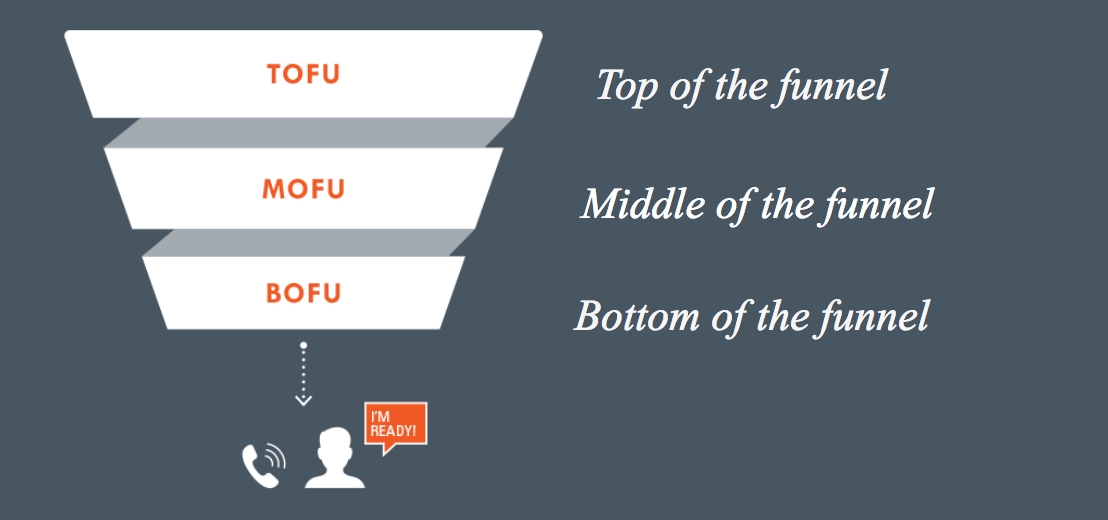
Although a single asset offered on a landing page is great for the initial capture of a lead. If you are in the B2B space, have a longer sales cycle or your product or service is at a higher price point, it's likely not enough to seal the deal and turn them into your customer.
Usually, before a person becomes your customer they must first travel through your sales funnel - consisting of the stages your customer goes through between becoming a lead and actually making a purchase. Although it has “sales” in the title, this funnel is actually at the heart of marketing. That’s because it’s a marketer’s job to motivate a person to move from one stage of the funnel to the next.
And the goals, and therefore mindset, of your potential buyer change drastically as they transition from one stage of your funnel to the next. And we call this series of changes in mindset the buyer’s journey, you may also hear it referred to as the marketing funnel.
The Buyer's Journey
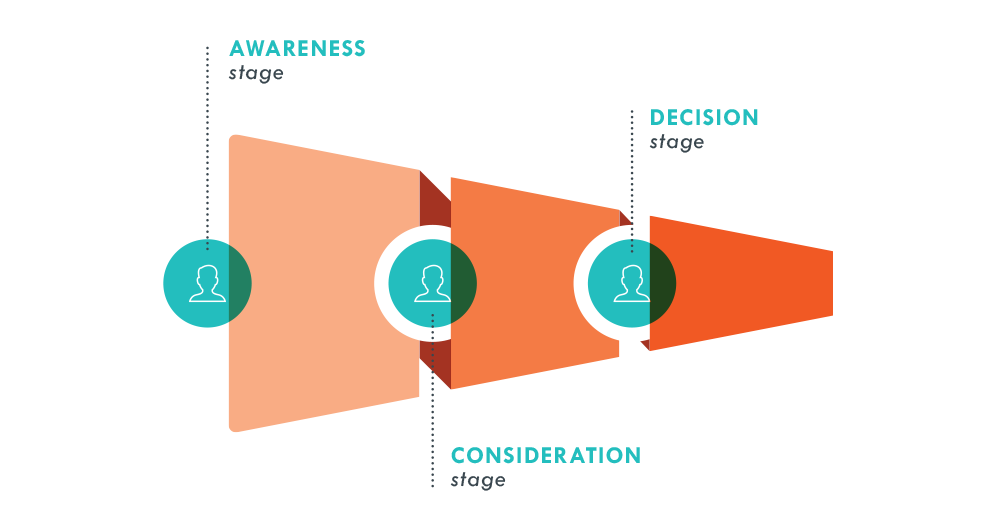
Typically the buyer’s journey is a three step process that aligns with the stages of your sales funnel:
- At the top of the funnel or TOFU we have the the awareness stage. This is where people are looking for answers, resources, and insight on a problem they are trying to solve, an answer they are seeking or a goal they want met.
- At the middle of funnel or MOFU we have the consideration stage. This is where people are considering the possible solutions for their problem or ways to meet their goal. And once they have determined the best solution, they begin an evaluation of the providers of those solutions.
- At the bottom of funnel or BOFU we have the decision stage. This is where people are making an actual purchase decision.
Each of these stages requires a different piece, or pieces, of educational content that speaks to the wants, needs and concerns of your prospective customers.
Stop right there, you have buyer personas right?
Now how do you know what your buyer's want, needs and concerns are? This all starts with developing buyer personas. Now I am not going to dive into that today, that would be a whole webinar onto itself. In fact if you have not developed personas for your business yet, you must start there. And we do have a workbook that will help you develop your personas if you haven't yet.
Where do we start?
When it comes to conceptualizing a campaign, you can start from the bottom up by asking what product or service do we want to promote right now and then what pain point/goal does it address?
Or you can work from the top down by asking what pain point/goal do we want to address (maybe a common one shared by your personas) and then what solution do we provide that addresses that pain point?
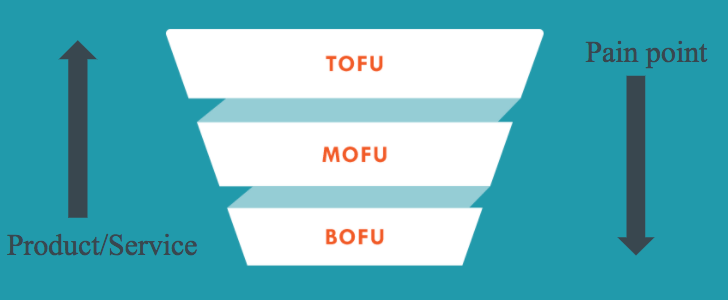
Either way, the campaign will start by addressing the pain point or goal and end with a decision to buy/or sample your solution.
Now that we know where we are starting and finishing - let's break down each piece of content to determine exactly what should be included in each content piece.
The Awareness Stage
In the Awareness stage, at the top of the funnel (ToFu), your buyer is trying to identify their challenge or an opportunity they want to pursue. They are also deciding whether or not the goal or challenge should be a priority.
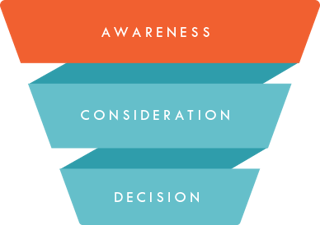
Understanding Your Buyer
In order to fully understand the Awareness stage for your buyer, ask yourself:
-
How do buyers describe this goal or pain point? (in their words; it may not be how you refer to it internally)
-
What are the top causes for this pain point or reasons this goal is not being met?
-
What does your buyer have to gain if this pain point is addressed or goal is met?
-
What are the consequences of inaction by the buyer? NEXT SLIDE
-
Are there common misconceptions buyers have about addressing the goal or challenge? (where might there be push back)
-
How do buyers decide whether the goal or challenge should be prioritized?
-
How do buyers educate themselves on this goal or challenge? (where do they look for information, what types or formats of information speak to them)
Your ToFu Asset
Once you understand the Awareness stage for your buyer you need to create a piece of content that includes the answers to these questions. Content formats that we have seen to be successful at this stage are guides, checklists, quizzes, worksheets and assessments.
Remember the goal at the end of engaging with this content is for your buyer to have identified their challenge or goal and decided to take action on it.
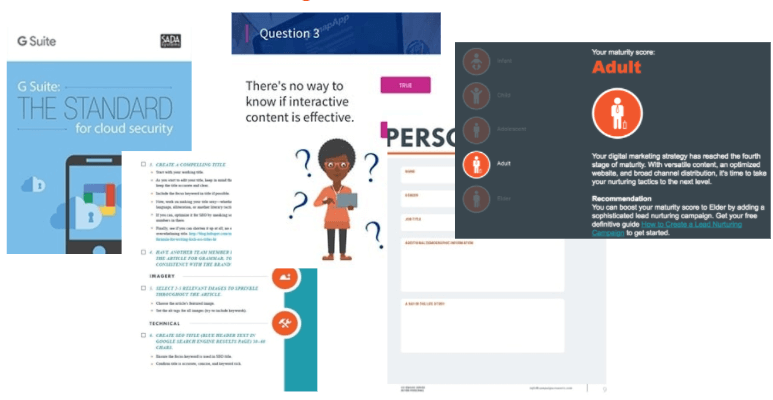
Example: ToFu for Marketing Mary
For example, we wanted to create an asset for our buyer persona Marketing Mary. One of her pain points is that she has a gap in her digital marketing capabilities. And we identified 3 primary causes for this gap. Either she do not having enough time or manpower to dedicate to it, the technical skills needed to execute the necessary activities or she lacks strategic direction.
Digital marketing spend continues to increase (from 57.29 billion US dollars in 2014 to 103.37 billion US. dollars in 2019; according to Forrester) so she knows this is a priority.
Which is why if addressed: Yes, her org will benefit, but ultimately its about Mary - she will feel a weight off her shoulders when she is able to fill the gap and bring these benefits to the org.
And if not addressed she will feel guilty, burdened by a never-ending to-do list, and lacking strategic direction. In sum, she will feel she is falling behind!
With this information in hand we created an interactive quiz, which through a series of 5 scenario based questions helped Mary to identify the main cause for her gap, which was either time, tech skills or strategy.
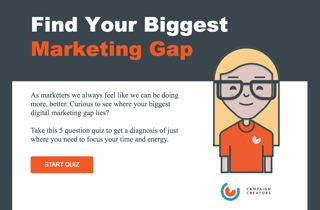
how do you link these pieces together to create a funnel for your leads to travel down? Our How to Create a Lead Nurturing Campaign [Guide] will walk you step-by-step through the process.
The Consideration Stage
At the Consideration stage, or middle of the funnel (MoFu), your buyer knows they have a problem that needs to be solved, or goal they are trying to reach, and are committed to addressing it. And now they are ready to evaluate the different approaches or methods available to pursue the goal or solve their challenge.
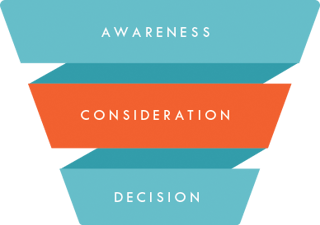
This point in the journey also marks a point of extended engagement where you’re nurturing a lead, building a relationship, and establishing trust between the potential buyer and your brand.
Understanding Your Buyer
In order to fully understand the Consideration stage for your buyer ask:
-
What categories of solutions do buyers investigate?
-
How do buyers educate themselves on the various categories?
-
How do buyers perceive the pros and cons of each category?
-
How do buyers decide which category is right for them?
Your MoFu Asset
The MoFu (Middle-of-the-funnel) offer teaches buyers how to solve their problem or meet their goal. And this is the stage where you can begin to make a case for why your solution in particular is the best fit.
You also want to help them determine if they’re not a good fit for your solution, which is important for customer retention in the long run. Remember, you are only interested in qualified leads.
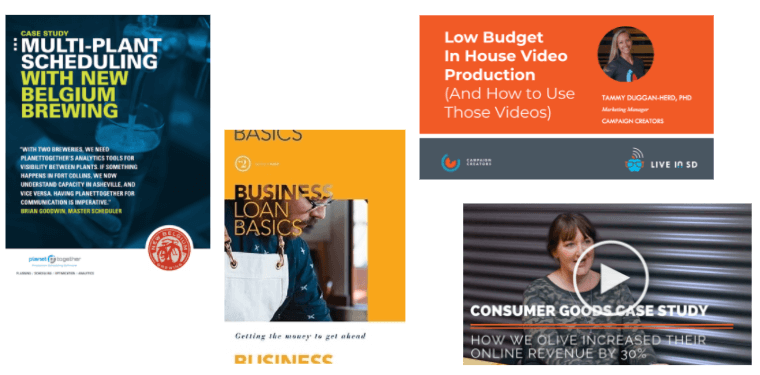
Formats we have found successful for a MOFU are case studies, whitepapers, ebooks, webinars, and videos.
Note: The Consideration phase may require several MoFu assets, especially in the case of very long sales cycles or complicated products.
Example: Two Stage Mofu for Marketing Mary
For example, we split our consideration stage for Marketing Mary into 2 MOFUs. In MOFU 1, Your Guide to Filling a Digital Marketing Gap, we outlined five different gap filling options, only one of which was ours - hiring a marketing agency.
This was followed by MOFU2, Filling Marketing Gaps: It's What We Do, which introduced Campaign Creators for the first time and featured six client case studies.
The Decision Stage
We have arrived at the Decision stage, or the bottom of the funnel (BoFu), where your potential customer has chosen the category of solutions to address their problem or goal - the “what”- but they need to determine which one -the “who”- can best provide that solution.
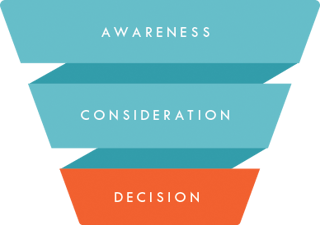
Understanding Your Buyer
Questions you should ask yourself to define the Decision stage are:
-
What criteria do buyers use to evaluate the available offerings?
-
When buyers investigate your company’s offering, what do they like about it compared to alternatives? What concerns do they have with your offering?
-
Who needs to be involved in the decision? For each person involved, how does their perspective on the decision differ?
-
Do buyers have expectations around trying the offering before they purchase it?
-
Outside of purchasing, do buyers need to make additional preparations, such as implementation plans or training strategies?
Your BoFu Offer
The bottom of the funnel is where someone is making the actual purchase decision. They’re ready to buy, but that still doesn’t guarantee that they’re going to buy from you. Answering the questions we went over will help you determine what your bofu offering should be. What can you give your lead that will give them that final nudge to make a purchase decision?
Your BoFu asset should also aim to assure the “who” they buy from is YOU. We suggest offering a consultation, quote, trial, demo or purchase promotion.
Example: BoFu for Marketing Mary
For example, Mary may be skeptical of agencies, she may have even worked with one in the past that left her with a bitter taste in her mouth. On the other hand she may have no experience working with a agency and is unsure of what the relationship would look like and if it's really worth investing the money in this option (likely the most expensive of the 5).
So we decided to give her the option to try before she buys with a free strategy session.
Now Tie It Up With a Bow
Now that you have your TOFU, MOFU and BOFU content in hand, its worth the extra investment to make it look good. In fact, when given 15 minutes to consume content, two-thirds of people would rather read something beautifully designed than something plain (Adobe). So pass it off to your designer to add that glossy finish.
And how do you link these pieces together to create a funnel for your leads to travel down? Our Lead Nurturing Masterclass will walk you step-by-step through the process.
This blog post is part of Your Definitive Guide to Lead Nurturing blog series.
Originally published January 6, 2018, updated July 8, 2019
Tags:
content marketing
B2B Marketing
lead nurturing

